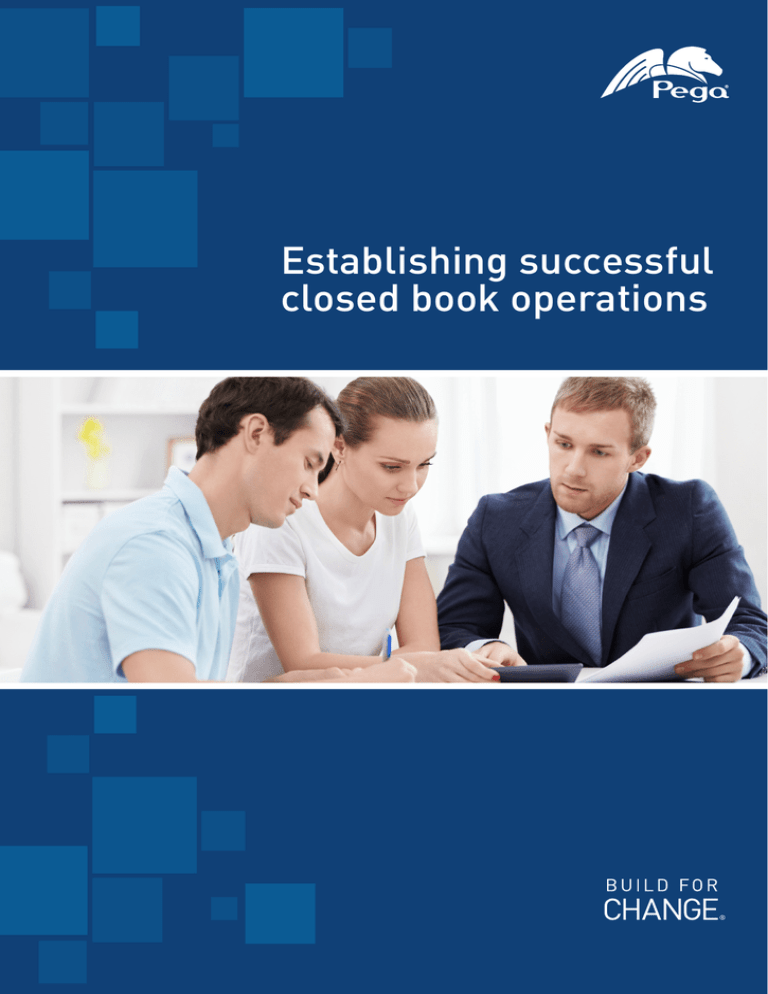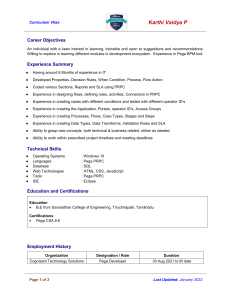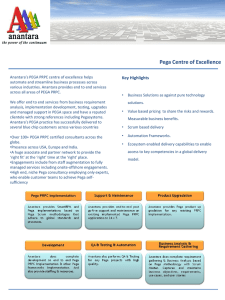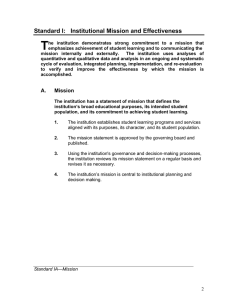
Establishing successful
closed book operations
2
The insurance market is not immune to the changes in
recent years in financial services. A combination of economic
recession in Europe and increased regulation has led to a
very challenging market. People are buying fewer savings
products and the burden of increased regulation, such as
Solvency II, has made these products more costly to service.
The combination of these two factors has led a number
of companies to discontinue unprofitable products. For
example, Zurich choosing to move out of the individual
pensions market in Germany and Prudential shifting
priorities and focus away from Europe to Asia Pacific are
clear indicators.
What is Closed Book?
When a company chooses to leave certain markets or discontinue particular product
lines, it puts them into what is known as “run off”. It stops new business sales and
accepts premiums only for existing policies. The book of business is then deemed
to be “Closed”. Closing the book to new business does not negate the company’s
responsibility for looking after existing policy holders. Life companies are required to set
up and hold capital reserves for the duration of the policies in order to meet the longterm liabilities associated with them. In addition, they have to administer the assets until
maturity of the last policy. There is little immediate prospect of a significant turnaround
in the savings and mortgage related life products against a backdrop of market
consolidation, increased corporate governance and capital requirements arising from
Solvency II as well as higher servicing costs. These factors make it likely that Closed
Book insurance will become a growing area of the market.
What are the challenges to establishing successful Closed
Book operations?
There are a number of considerations that companies who seek to consolidate Closed
Book insurance products must consider. Capital requirements in terms of leverage
and debt are becoming more onerous which may explain why it is now attracting less
private equity investment. Profitability of funds is low and savings made in areas such
as marketing and sales may be offset by IT costs related to managing, migrating or
updating legacy systems in order to meet new regulatory requirements. Operational
efficiencies may be achieved through economies of scale such as the acquisition of
more closed book policies to offset constantly decreasing portfolios as policies close
or by lowering costs to maintain profitability until the last policy is closed. Maintaining
customer service becomes increasingly difficult as the residual experience and skills
base to service clients using legacy systems and processes decline. Lack of contact with
customers in areas such as new business processing, servicing and claims also erodes
brand loyalty. With no independent advisor or agent, there is no avenue for advice or
service to cross-sell or up-sell.
3
Closed Book - What Are the Options?
Of the options available, all have advantages and
disadvantages:
Disposal – This option is attractive if there is not a compelling reason to keep the book
and it would not make commercial sense to migrate the book to another system in order
to consolidate administration costs. In this instance sale to a Closed Book consolidator
would be the best option.
Outsourcing – This is a sensible proposition in cases where the business value is
low and the risk and cost of transfer are also low. Retaining control of the book in this
instance is not important; consequently there is a temptation for companies to simply
transfer responsibility for migration to the outsourcer. This is not always a wise course
of action for the outsourcing party as the true value of the assets is hard to accurately
ascertain and true complexity involved on servicing the book is hard to gauge. Therefore
the risk of failing to get full value from the assets and in negotiating sufficiently stringent
and cost effective service level agreements are quite high. This option provides certainty
of cost into the future but risks leaving money on the table if some “house cleaning” is
not done first. Looking at migrating as an option will almost certainly pay dividends in a
number of cases because the cost of migrating to Pega is a fraction of what migration
would have cost in the past.
Third Party Administration – Utilising a third party administrator (TPA) is where the
TPA takes the book onto its own IT system but provides the necessary feeds to the life
company’s internal systems in order to produce the required reporting for management
and compliance purposes. Customer service is maintained either through service level
agreements or retained by the life company to ensure customer satisfaction remains
high and future commercial opportunities can be exploited. This is a good option when
the business value is high and the risk and cost of transfer are low.
Keep the Book of Business – This is the route to adopt if the business value to the
company is high and the risk and cost of transfer to another party are also high. In this
case, there are advantages in retaining control of the administration of the book on the
existing IT platform. Some companies have elected to offshore these operations but
the problem here is that they still incur annual increases in operational costs against
a decreasing value on the book of business. Invariably the residual system skills and
customer service contact decline over time. Without agents to advise clients, crosssell and up-sell opportunities are lost, impacting customer loyalty.
4
Migrate – This is where the value to the business is still high but the risk and cost of
transfer are slightly lower. It is similar to the keep option but the advantage of moving
to a more manageable and cost effective system is much more compelling. The
problem is that for many companies, successful migration has failed to materialise
and the risks and costs involved have outweighed the business benefits. Additional
regulatory burdens have only exacerbated these challenges.
This is where Pega really pays dividends in the Closed Book space. Up until now
there have not been systems capable of receiving and administering the Closed Book
adequately and cost effectively. With Pega this situation has changed.
Whether you are an insurance company looking to run existing Closed Book funds
optimally or seeking to avoid leaving money on the table by outsourcing or with
a consolidator, Pega fundamentally changes the cost benefit analysis. Specialist
outsourcing service providers can also reap huge benefits by adopting Pega because
of the sizable productivity, customer service and system integration benefits
achievable. Productivity improvements alone amount to more than 30% in most cases.
Traditional
Solution Steps
Legacy
System
Migration
Optimise
Exploit
Keep
Legacy
N/A
N/A
N/A
Migrate
Legacy
Migrate
Internally
Optimise
Internally
Exploit
Internally
TPA
Legacy
Migrate
Externally
Optimise
Externally
Exploit
Externally
Outsource
Legacy
Migrate
Externally
Optimise
Externally
Exploit
Externally
Dispose
N/A
N/A
N/A
N/A
Commercially viable
options before Pega
Life Company
Third Party
5
Commercially viable
Pega
Solution Steps
Legacy
Optimise
Exploit
Data
Migration
Keep
Legacy
Optimise
Internally
Exploit
Internally
N/A
Migrate
Legacy
Optimise
Internally
Exploit
Internally
Migrate
Internally
TPA
Legacy
Optimise
Internally
Exploit
Internally
Migrate
Externally
Outsource
Legacy
Optimise
Internally
Exploit
Internally
Exploit
Externally
Dispose
N/A
N/A
N/A
N/A
options post Pega –
Note how the options
become more attractive
through earlier benefit
delivery and reduction
in risk
Life Company
Pega
Third Party
Fast, seamless and efficient migration is pivotal to Closed
Book profitability
Pegasystems’ approach has significantly reduced the difficulties inherent in adapting
and migrating legacy systems. It does this by reordering the process of addressing
legacy IT. It removes the need to undertake system migration to a new system before
the benefits of Closed Book can be introduced. It enables companies to enjoy business
optimisation and efficiency improvements before migration and it significantly lessens
the risks associated with internal or external migration. This is achieved through
Pega’s ability to allow the business processes and user interface or, in some cases,
multiple instances of them, to be sequentially replaced by a single Pega layer. Step by
step, as the business dictates in manageable 90 day chunks, the legacy business logic
and supporting processes move onto the Pega layer. This eliminates any prospect of
“big bang” failure as a new system goes live.
“As is” processes can be automated, improved or eliminated as required. New or
improved processes and approvals can be adopted and tested “on the fly” so that the
maximum operational and business performance benefits can be achieved throughout
the migration process. Once migration is complete, continuous improvement can be
achieved without the need to alter the underlying legacy systems or architecture.
6
New levels of functionality and productivity are achievable
No matter how old the legacy systems are, Pega enables new levels of functionality to
be achieved. A single Pega User Interface with predominantly the same process, allows
multiple workforces to be transformed into one “virtual” workforce across multiple books
and even geographies, driving cost reduction. An easy and intuitive Pega user interface
means training time is greatly reduced.
A single set of screens accessing multiple databases ensures that agents focus on
customers not “window hopping”. Analytics and “Next Best Action” ensure high levels of
customer service linked to optimal business outcomes so every agent becomes an expert.
Pega’s architecture pulls process maps and rules definitions into what we call a
“Situational Layer Cake” which has a number of layers, all inheriting rules (rather than
re-writing them every time) from a more general layer below. When the system receives
a request, it automatically finds and assembles the specialised processes, or cake layers,
relevant to a given customer, jurisdiction, regulator, channel and product situation.
Only Pega does this dynamically and in real time, providing massive reusability and
increased operational efficiency across the entire organisation. The significance of the
layer cake approach is that it enables financial services companies to make regulatory
or product changes and introduce new products and services in a matter of days or even
hours.
The way forward
For companies seeking to manage their Closed Book business, Pegasystems provides a
unique solution that mitigates the risks associated with migration. In addition the solution
lowers operational costs, maximises customer service levels and ensures new regulatory
and process requirements can be rapidly adopted. Cost effective continuous improvement
becomes achievable and sustainable. Pegasystems is a genuine “game changer” for the
Closed Book market.
7
About Pegasystems
Pegasystems revolutionizes how leading organizations optimize customer experience and automate
operations. Our patented Build for Change® technology empowers business people to create and
evolve their critical business systems. Pegasystems is the recognized leader in business process
management and is also ranked as a leader in customer relationship management software by
leading industry analysts.
© Copyright 2013 Pegasystems Inc. All rights reserved. All trademarks are the property of their respective owners.
INS 2013-04








